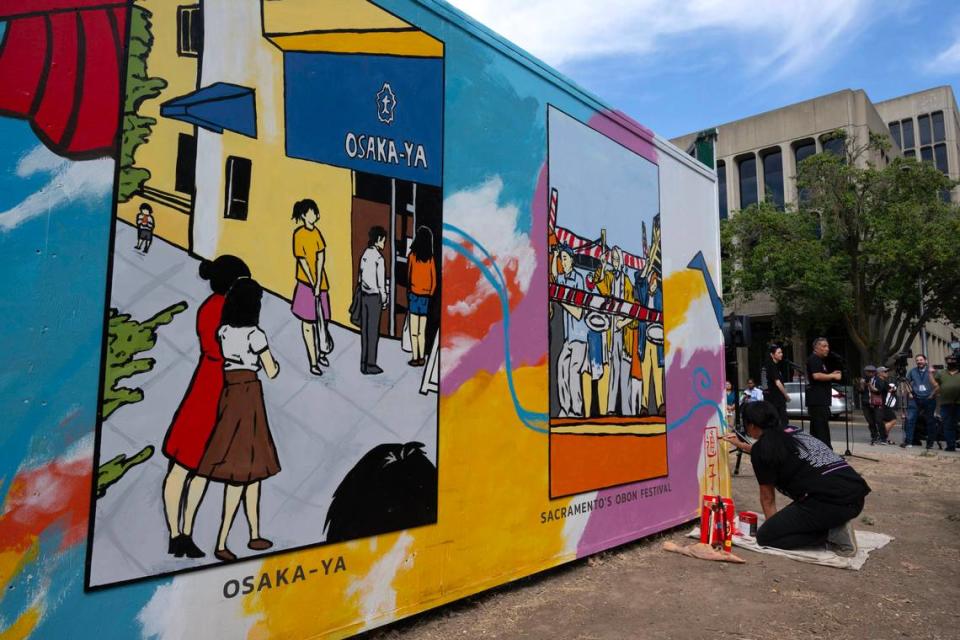Reclaim Sacramento Japantown dedicates new mural to ancestor’s lost history. Take a look
There are parts of this city that hold historical significance many born and raised in Sacramento may not know about.
The Wells Fargo Center on Fourth Street, the Downtown Commons parking lot, apartment buildings, office towers and more in the surrounding area are not the original buildings that inhabited those plots of land. These buildings were once Sacramento’s Japantown.
It’s been 82 years since Japanese inhabitants were forcibly removed from Sacramento and sent to internment camps. Recently, their descendants have taken up the call to rebuild and reclaim Japantown.
This week, members of the Reclaim Sacramento Japantown group dedicated a mural meant to “raise the visibility and to make people aware that Sacramento Japantown actually existed here, because not many people knew about it,” said facilitator Jim Tabuchi.
Reclaim Sacramento Japantown formed to educate and raise awareness about the former existence of Japantown, a neighborhood in Sacramento’s segregated West End district.

Japantown, also known as Sakuramento, incorporates the Japanese word “sakura” which means “cherry blossom.” It was once home to the one of the largest Japanese communities in the country.
People could easily find Japanese pharmacies, restaurants, hotels, medical offices and more in this 15-block area that centered around Fourth Street and Capitol Avenue (formerly M Street).
“At its peak, Japantown contained 3,500 residents and 450 businesses,” the Reclaim Japantown’s website says.
Back in 1942, Japanese residents in the U.S. were evacuated and detained to internment camps during World War II. An estimated 120,000 Japanese Americans and Japanese nationals were incarcerated. This decimated Sacramento Japantown.
While the neighborhood was able to rebuild years later, Japantown residents were again forced to relocate when the Sacramento City Council proposed the Capitol Mall Project in 1950. The project was meant to connect the riverfront to the state Capitol which would have cut straight through Japantown
This redevelopment project encompassed the entirety of the 15 blocks that made up Japantown and cited “eliminating blight” as the reasoning for choosing the specific location, according to Grinnell College.
While a majority of the businesses moved to other areas of Sacramento, today, only a few of the original businesses remain in their historic home. Osaka-Ya, a Japanese confectionery shop, and Nisei Barbershop, are among the handful that endured.
What does the Japantown mural look like?
The actual mural has three different viewpoints and utilizes the street corner it is placed on. The mural is meant to be visible to the public regardless of where they are standing.
The centerpiece of the mural is an expansive Japanese cherry blossom tree that spells out Sakuramento in Katakana — one of the three Japanese alphabets — down the center. Bright colors such as light pink, golden yellow and orange catch passerby’s attention.
Karen Tsugawa, the creator of the mural, said the design mimics traditional Japanese playing cards called hanafuda. Drawn to the “the colors and the stylization,” Tsugawa replaced the playing card images with renderings of historic photographs taken in Japantown.
Eight different panels in the mural depict specific Japantown businesses like Ouye’s pharmacy and Sun Rise Laundry, both of which are not in operation today.
Tsugawa also made sure to add in relevant Japanese motifs such as the Manchurian crane. She incorporated aspects of herself as well to honor her heritage.

In the mural, the painting of a peacock represents her grandparents and a phoenix is a nod to Tsugawa’s Chinese heritage.
Similar to many inhabitants of Sacramento, Tsugawa did not know Sacramento had a Japantown. She said having the opportunity to learn about her culture and family’s history has been informative, not only as an artist, but as a Japanese American.
Although this was her first time doing such a big project in a high visibility area, she said it’s “really been an honor” to create the mural in the place where her grandparents grew up.
Working on the mural Fridays-Sundays every week, Tsugawa was able to complete it in a month, with the help of volunteers.
The mural is located on land owned by the Shingle Springs Band of Miwok Indians. Tabuchi said Reclaim Sacramento Japantown reached out to the tribal council and was granted permission to use their vacant lot as the display site for the mural.
While the location for the mural is temporary, Tsugawa hopes that once the mural is taken down they are able to give it a permanent home “where it could grow, expand and be super accessible,” she said.
The mural is in a high traffic spot, just blocks away from Tower Bridge. Tabuchi said it’s an optimal “selfie” spot.
“We hope that the view of the mural will spread worldwide and give people from outside of Sacramento a reason to stop,” Tabuchi said.
In attendance at the dedication ceremony was Sacramento Councilwoman Katie Valenzuela.
“I know I was not on the city council, obviously, when the displacements occurred back then, but the city of Sacramento did hold a role in what happened here,” Valenzuela said. “On behalf of the city of Sacramento, I do want to apologize to everybody who was alive then, (and) to everyone who has come after.”


